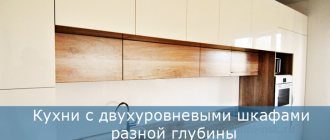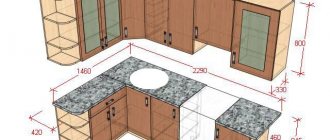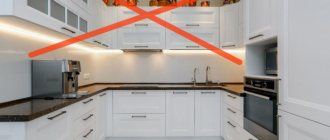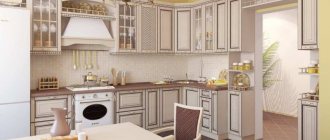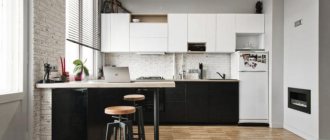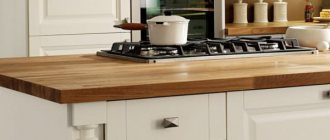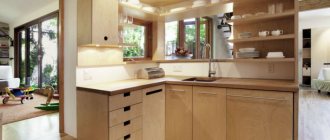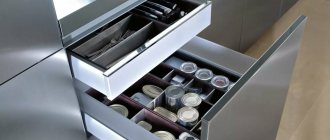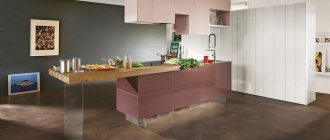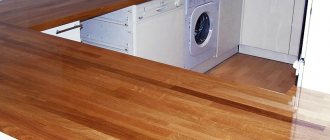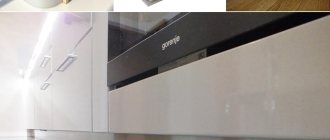What is a modular kitchen?
A modular kitchen can be called a construction kit for adults. Typically, a manufacturing company produces several construction blocks within one collection. It is best to consider this concept with an example. Ikea was one of the first on the market to start producing modular kitchens, so in honor of respect, let's take it as an example, namely its Knoxhult series. It is available in several colors, consider gray - it’s in the photo.
Like any kitchen cabinets, modular ones can also be divided into upper and lower.
There are three types of wall cabinets:
- single;
- double;
- single narrow for hood.
And there are three floor cabinets:
- narrow, consisting entirely of drawers (40 cm wide);
- cabinet with doors, drawer and space for embedding a stove (width 180 cm);
- wardrobe with drawer and two doors (width 120 cm).
A modular kitchen is a new solution on the market, in which the buyer independently creates his own kitchen from blocks: this is what distinguishes it from a conventional built-in kitchen set.
They can be arranged in different ways: you can buy several floor cabinets with a width of 40 centimeters and be satisfied with only them. Such a designer makes the imagination work.
Characteristics of modular systems
Each set of modules has its own characteristics, width being one of the most important. In addition, each manufacturer of modular systems offers elements characterized by their own pitch. Typically its size ranges from 5 to 20 cm.
When choosing modular kitchens, you should pay attention to the frame. It can be of two types - glued and prefabricated. The first option assumes that the elements are delivered to the site in finished form. Prefabricated facades are assembled at the buyer's home.
Assembly of a modular kitchen
The frames of the sets are most often made from modern material - laminated chipboard. This is a very economical material that is safe for health. In addition, chipboard is practical, the facades will last a long time. Today, everyone can choose kitchens by element, focusing on their own budget.
Related article: Sealing a bathtub with a wall
To make the facade, manufacturers use the following materials: chipboard, MDF, wood, glass, plastic. The surface of chipboard and MDF can be laminated, varnished and veneered. Manufacturing companies can use metal and various combinations of materials when producing modular systems.
The format may be different - it all depends on the preferences of the buyer. There are also planes on sale that can be opened with the touch of a finger, and other modules for the kitchen. Manufacturers offer modules with traditional hinged doors, as well as vertical curtains made from horizontal slats.
Metal kitchen set
When buying modular kitchens, you should pay attention to the countertops.
This element can be made of different materials, but it is the material of the countertop that has a significant impact on the final cost of the kitchen. Chipboard countertops have the lowest price, followed by steel and ceramic tiles. Countertops made from artificial stone are even more expensive, while products made from natural wood and natural stone complete the list.
Pros and cons of buying a ready-made kitchen
Of course, such a new phenomenon immediately has supporters and opponents. The latter cannot come to terms with the fact that they don’t have to wait for a kitchen for several weeks, as before, but assemble it themselves from blocks. To understand how to feel about such a new piece of furniture, it’s worth understanding all the advantages and disadvantages of the product.
Advantages
Block kitchens are quickly gaining popularity, due to the large number of advantages of such a solution:
- a design project is not needed, since all modules are standard. The buyer himself selects the necessary elements and combines them at his own request. On the websites of retail stores there are often design programs where it is easy to select the necessary modules for a specific room;
- Collections most often contain several types of modules, among which you can always find what you need;
- suitable for both large and small kitchens;
- calculation of the cost of the kitchen becomes absolutely transparent;
- you can easily update the interior;
- the ability to purchase a separate module;
- installation is so easy that you can do it yourself;
- budget cost;
- simplicity - in fact, this is a ready-made solution from which you just need to select the necessary elements;
- easy to transport;
- high functionality;
- The wait for the kitchen is reduced to a minimum - most often it is in stock in the store itself, but sometimes there is a need to wait for delivery from the warehouse.
Look how many advantages have accumulated. Modular kitchen - it's fast, cheap, easy!
Advantages of modular kitchen furniture
Property owners, by choosing a modular system, can rationally use the space. If after some time the owner of the apartment wants to change the interior, then he just needs to swap the modules.
One of the advantages of a modular kitchen is that its parts can be rearranged.
Modular furniture has good spaciousness. It is easy to transport and does not require special skills during installation. Kitchen furniture is distinguished by high functionality; every housewife will be able to choose a set of the most suitable cabinets and drawers.
Components
The number and types of modules differ not only between different companies, but also in different series of the same company. For this reason, finding the perfect lockers can be quite difficult. But in the end, you will get a kitchen that best meets the needs of the housewife - cooking with this is a joy.
Wall cabinets most often come in the following types:
- with drying - they are placed directly above the sink;
- tableware (rarely found among modular ones) - with a glazed facade, behind which a beautiful service can be seen;
- open - without door. Perfect for a country or Provence style kitchen;
- straight, blind - the most ordinary cabinet with the usual door.
It is worth noting that this difference is only in appearance. They can also vary in size. This also applies to the lower level headset. The most commonly presented modules here are:
- under the sink - a necessary thing in every kitchen;
- with shelves - most often they are wide and designed for storing large utensils (pans and pots);
- with drawers - a very practical module, where there is more effective space compared to the usual option with shelves;
- combined - universal modules with both shelves and drawers;
- with a niche for built-in equipment - you should select based on the availability, type and size of the equipment itself;
- pencil case - a tall narrow cabinet.
One series does not necessarily contain all of the above modules. The manufacturer may have only two upper and three lower ones. When choosing, you should proceed from your needs: if there is no built-in equipment, then you don’t need a cabinet for it.
Disadvantages of modular furniture
Among the disadvantages of modular furniture, it is worth noting the likelihood of gaps appearing between several modules. They usually occur due to uneven floors, as well as an error in the selection of elements.
Before you go to the store, you need to decide on the style of the interior. If you want to buy a modular kitchen for a small space, you should remember that the simpler the style, the better the interior.
Furniture made in modern and high-tech styles looks good in small kitchens. When purchasing, you should give preference to those sets that have muted tones of the facade. Furniture in light colors looks good. Such items will visually expand the space and will not clutter up the kitchen. It is not recommended to choose modules with brightly colored facades for small spaces.
Related article: Green curtains in the living room interior - universal design
Light-colored modules will visually expand the space
It is best to purchase several cabinets and cabinets. You shouldn’t fill all the free corners with objects; this approach will avoid unnecessary cluttering of the space. In order to divert attention from a small area of the room, you should pay attention to cabinets with mirror surfaces.
Don't buy a kitchen corner; it's better to stick with a table and chairs. This will significantly save space. Be sure to do a design project, think about where you can place the refrigerator.
It should be noted that today almost all kitchens are selected based on the principle of assembling modular elements. This means that each buyer, having looked at the catalog, can choose the most suitable configuration of the kitchen set, focusing on the desired appearance, size and functionality of the furniture. In stores, an experienced manager helps the buyer make a choice. This allows the client to receive an individually selected headset at the best price.
For a small kitchen it is not recommended to choose modules with bright facades
In the catalog of many stores you can choose elements from a variety of materials. Ready-made modular systems are a good way to create functional space in the kitchen.
Standard module sizes
Dimensions may vary among different companies. The record holder here is Ikea with its 180 cm in the lower tier and 120 cm in the upper. Usually these values are much more modest, and the essence is this: one cabinet - one module.
Hence the standard module width:
- 45 cm,
- 50 cm;
- 60 cm;
- 75 cm;
- 80 cm.
This dispersion is due to the fact that different companies have different views on kitchen units, and they cannot come to a common decision.
It is best to first measure the existing kitchen that needs a new set, and then draw a rough plan yourself. Then, according to this plan, it will be much easier to select the necessary modules, because household appliances such as a refrigerator, stove, hood, dishwasher or washing machine, and so on will already be taken into account.
The only thing that almost all manufacturers agreed on was the height of the lower tier. In modular kitchens it reaches 85 cm, taking into account the base (10 cm) and countertop. This is a comfortable height for people of average height (160–175 cm); others should think about trimming the base or additional legs.
It is important to consider the depth of the cabinets - it is also quite standard:
- 30–40 cm - for the upper tier;
- 60 cm - for the lower tier.
In this case, the tabletop should be 63–65 cm deep so that it forms a small canopy over the facades. Typically, modular kitchens already come with an ideal-sized countertop.
Economy class modular kitchens: procedure for selecting cabinets
Kitchen furniture is changed in two cases: during a major renovation or if necessary/desirable to replace the old one. What would seem to be the difference? Big. If you have to renovate, you can first choose a kitchen, then change the layout of the water supply and sewer pipes, move the sockets to the right place, rearrange the stove, etc. In this case, you can select the functionality you need from the elements of a modular kitchen, without being particularly tied to anything.
Economy class modular kitchens are selected element by element
Another approach to the selection of modules if the repair does not involve major work. No one will move the sink and gas stove. And this must be taken into account. First of all, then draw a kitchen plan with dimensions, determine the location of the sink, draw a stove, and a refrigerator. Everything that you are not going to move. Draw all elements to scale. For example, you can use a checkered leaf and take two squares as 10 cm. It will be easy to draw and put down dimensions too. After devices that no one will move are placed on the plan, the algorithm for selecting modules is as follows:
- Select a table for the sink.
- If available, choose corner cabinets.
- Determine the dimensions of cabinets for built-in household appliances.
- Decide if you need end cabinets and what size they will be.
- Fill the remaining free space with linear cabinets, matching their width and functionality.
This algorithm allows you to assemble a modular kitchen element by element according to your dimensions in just a few hours. You just need to first measure the length along each wall.
Types of modular cabinets
If you decide to install a modular kitchen, you need to know that they come in different types. There are differences in the type of layout, type of opening or type of installation.
But, it must be honestly noted, these factors very rarely become decisive when choosing a block kitchen. First of all, they look at the appearance, content and cost.
Layout
Most often, the modular kitchen itself does not imply any specific layout. But with its help you can create all of the following options:
- linear - the most common option for arranging furniture, the essence of which is that all cabinets are placed on only one wall. This layout will suit any room. Most often there are both wall and floor cabinets. The ease of arrangement leaves plenty of room for a varied arrangement of modules and decor. Another small advantage is that the fewer cabinets, the lower the cost;
- parallel - with this layout, furniture is placed on two opposite walls. There is a lot of storage space, so you can often see a refusal to use wall cabinets. This layout greatly affects the geometry of the room - visually it becomes narrow, so the dining area is moved to another room;
- corner - another standard layout option that is suitable for any kitchen. As the name implies, cabinets are placed on both sides of one corner, that is, on adjacent walls. This layout is considered one of the best because it creates an ideal work triangle;
- U-shaped — arranging furniture in a U shape is suitable for spacious rooms. Cabinets can stand along three or two walls. In the latter case, instead of cabinets, a bar counter is usually installed, which at the same time zones the space. The dining area is most often removed from the kitchen, but sometimes it is located near the fourth wall;
- island - a very beautiful and multifunctional furniture layout option, in which several floor cabinets are placed in the center of the kitchen, forming an island. But modular kitchens are considered budget-friendly, so it’s very difficult to find options for an island here.
The advantage of modular kitchens is that if the housewife initially wanted a corner kitchen, but then realized that a linear one was enough for her, this is very easy to fix: just remove the necessary module.
This will not work with any bespoke kitchen, because it is made in one piece. It’s a little more difficult to make a corner kitchen out of a linear kitchen—you’ll have to buy the missing blocks.
By opening type
Here we will only talk about corner cabinets. A used corner in the kitchen is always a plus because it creates a lot of storage space. They also usually move the sink here, creating a large work area. For ease of use of the corner area, two types of modules are made, which differ in opening:
- two separate cabinets - two separate doors opening in different directions. This option is not the most convenient, since not all storage space is easily accessible, but it is more economical;
- one corner cabinet - this module has only one door. It can be folded like a book, so there is more access to the interior space. This option is more expensive.
If the kitchen is small, then it is better to pay extra for comfort. If you have enough storage space, you can put things that are rarely used in a corner.
By installation type
It is worth noting that modular kitchens come in different types of installation. This affects the form in which the buyer will receive the kitchen “at the checkout,” or most likely from the warehouse. Option two:
- glued - the buyer receives them already in the form of ready-made boxes. All that remains is to screw the door and handle to it. And, of course, hang and place all the boxes in their places;
- prefabricated - this is exactly the method that Ikea practices with its furniture. The buyer receives a flat box with all the necessary boards, fasteners, instructions and even some tools. After this, there are two ways - do it yourself or hire a assembler. In fact, there is rarely anything complicated in such instructions. Sometimes during assembly you can even do without power tools, but hanging the upper tier can be difficult due to the weight of the cabinets.
MDF and chipboard are soft materials that require virtually no physical strength to assemble. All that is necessary is to strictly follow the instructions without unnecessary thoughts like “This part is unnecessary” or “This bolt will not play a role,” which is why kit kitchens are often installed independently.
What are they?
Depending on the type of installation, modular kitchens can be: linear, corner, U-shaped and island. Each of the listed options may differ in the presence or absence of one/several elements.
- Linear ones are installed along one of the walls. Suitable for installation in any size room.
- Corner units include a corner cabinet and a wall cabinet. Such an item connects modules that are placed along two walls. They are chosen for medium-sized kitchens or for arranging a kitchen area in a studio.
- U-shaped ones are placed along three walls. Includes at least two corner modules. Suitable for spacious rooms.
- Island. Unlike the previous ones, they have modules in the form of a floor cabinet, which can be installed in the center or attached to others.
Depending on the style of execution, there are: single-row kitchens, which consist of floor cabinets and cabinets; double-row, including floor and wall cabinets.
Materials for the manufacture of cases and facades
Modular kitchens are made from materials that meet the price-quality requirement. That is, it is very difficult to find super-expensive options, but you should not expect that such a kitchen will last 50 years.
Locker body
There is a very small choice here - chipboard or MDF.
| MDF | MFD boards serve as a base on which almost any coating can be applied: · acrylic; · film; · veneer; · even glass and metal. The main positive feature of the MDF panel is its environmental friendliness, because it is produced by strong pressing of wood shavings. And the variability of the top covering allows you to create furniture to suit any style. It is considered a material resistant to humidity and temperature changes. |
| Chipboard | Chipboard is a cheaper and more dangerous analogue of MDF. Chipboard is also made from wood chips, but with the use of chemicals that can be harmful to health. It is for this reason that chipboard should always be purchased in large stores or trusted places where quality is monitored. The top of the panel is covered with film and protective varnish, but even this does not guarantee protection from moisture and steam. When exposed to water elements, it often swells and collapses. |
If you have a choice between MDF and chipboard, it is better to overpay a little for quality - such a kitchen will please you for much longer.
Facing
| Plastic | Plastic kitchens are now very popular, because the color palette is practically unlimited, which means that every housewife will find an option to her liking. In addition, plastic is cheap and practical - it is resistant to scratches and moisture, and is also easy to clean. |
| Frame | The most versatile and unusual option. Module doors are made of frames into which various panels can be inserted, for example, glass, plastic or chipboard. This allows you to quickly update the kitchen interior if necessary or desired. But there is also a disadvantage of frame cladding - the panels must be selected carefully, as gaps may form. |
| Acrylic | It is considered a denser and more durable material than plastic, but in other properties they are very similar. Acrylic costs 2 or more times more than plastic. |
| Laminating film | Lamination is the process of applying special paper impregnated with a composition that protects the surface from moisture, scratches, damage and maintains a presentable appearance. One of the most popular ways of cladding the facade of an economy class kitchen. |
| PVC or polypropylene film | The cladding process is similar to lamination, but in this version the film has a plastic base, which ensures maximum protective characteristics. In addition, it looks so beautiful in appearance that it competes even with natural materials. |
| Veneer | Veneer is a very thin sheet of wood that is glued to the facade to give it the appearance of solid wood. Even a specialist will not always be able to distinguish veneer from solid wood, but you will have to pay for such beauty - this is the most expensive type of finishing. |
Material
Since the set will be subject to various influences every day, you need to select a material that will be resistant to everything. Of course, the cost will directly depend on what the furniture is made of, but it’s better not to save on this.
Manufacturers offer several options for making a kitchen set.
- One of the cheapest and most popular materials is MDF.
- It consists of pressed sawdust, which is then coated with acrylic.
- This is a material that is quite wide in color and varied in design, which is more susceptible to the effects of steam or water.
- Because of this, it can swell and become deformed, so you should not place devices that can release steam under wall cabinets.
- You should also handle water carefully and wipe off the moisture immediately before it has time to be absorbed into the headset.
Chipboard is also used as a material. These are the same pressed sawdust, but they are superior to MDF in terms of stability, because they are covered in film.
The film prevents moisture from penetrating the material itself, and also protects the human body from harmful fumes of formaldehyde, which may be contained in the material.
Style and design
The appearance and materials of modular kitchens quite limit housewives and designers, because not every style can be matched, for example, with plastic cabinets. For this reason, it is worth preparing in advance by examining the basic design options for modular kitchens.
The beauty of the kitchen is important, because the whole family will gather and spend time there. But you shouldn’t sacrifice practicality for the sake of beauty, because this is where the housewife spends most of her time, surrounded by high humidity and temperature. This is in addition to the fact that it is necessary to maintain cleanliness in such difficult conditions.
So, the main design directions of modular kitchens are:
- classic or neoclassical. Although a classic interior and a modular kitchen at first glance are not compatible at all, this is not so. Modern technologies almost perfectly imitate the texture and texture of wood, and if you choose a natural shade, then it is practically indistinguishable from solid wood. The main thing is to hide all modern technology behind the facades;
- Art Nouveau is a bold style that combines geometry and smoothness, complex textures and contrast. Here, household appliances do not interfere with the overall picture, so they can calmly stand in their place. Plastic or acrylic plain facades are perfect;
- loft or fusion - these styles love to combine incongruous things, so having a modular kitchen won’t hurt. The main thing is to add some retro elements, bright accents and roughness like brickwork to modern textures;
- High-tech is a direction in which convenience and functionality come first. The latest technologies are used here, and every square centimeter should be useful. Gloss is welcome, so you can often find an abundance of metal and glass in a high-tech kitchen;
- country, Provence, chalet - here the situation is similar to the classics. If you choose a set made to look like wood, then a modular kitchen can take root in rustic styles. In this case, you can abandon the doors on the upper set and place a beautiful ceramic service there. Sometimes they do away with the door in the lower tier, covering it with a curtain;
- Scandinavian - to create the atmosphere of Scandinavian cuisine, you should take a closer look at the light modules made to look like birch. The surface can be glossy or matte. The facades are solid or glazed. Otherwise, you should stick to minimalism.
When choosing a style for your kitchen, you need to focus primarily on yourself - your lifestyle, hobbies and character. You should not run after fashion trends, because they become outdated too quickly - and there is a high chance of being disappointed in your choice.
Economy class modular kitchens: procedure for selecting cabinets
Kitchen furniture is changed in two cases: during a major renovation or if necessary/desirable to replace the old one. What would seem to be the difference? Big. If you have to renovate, you can first choose a kitchen, then change the layout of the water supply and sewer pipes, move the sockets to the right place, rearrange the stove, etc. In this case, you can select the functionality you need from the elements of a modular kitchen, without being particularly tied to anything.
Another approach to the selection of modules if the repair does not involve major work. No one will move the sink and gas stove. And this must be taken into account. First of all, then draw a kitchen plan with dimensions, determine the location of the sink, draw a stove, and a refrigerator. Everything that you are not going to move. Draw all elements to scale. For example, you can use a checkered leaf and take two squares as 10 cm. It will be easy to draw and put down dimensions too. After devices that no one will move are placed on the plan, the algorithm for selecting modules is as follows:
- Select a table for the sink.
- If available, choose corner cabinets.
- Determine the dimensions of cabinets for built-in household appliances.
- Decide if you need end cabinets and what size they will be.
- Fill the remaining free space with linear cabinets, matching their width and functionality.
This algorithm allows you to assemble a modular kitchen element by element according to your dimensions in just a few hours. You just need to first measure the length along each wall.
Without a doubt, the kitchen is the main place in the house where the whole family gathers. And it is quite natural that every housewife strives to make the kitchen not only beautiful, but also functional and compact. Today, interior designers offer kitchens for every color, taste and budget. And if it is not possible to buy expensive kitchen furniture, then you can find alternative options, which can be a custom-made kitchen or a modular kitchen.
A modular kitchen is an excellent replacement for expensive built-in units. A modular kitchen is practical, functional, and most importantly, you can “assemble” it yourself, creating your own original and unique design. Modular furniture must be aesthetically pleasing and meet all technological parameters for its operation. Modern modular furniture is very diverse and each set is made in a specific style. Modular furniture includes tables, chairs, shelves and cabinets. Many include shelving or components for built-in appliances, such as a refrigerator, microwave or dishwasher. You can also choose the facade of the kitchen and doors itself. So in a spacious kitchen you can make folding doors, and in a narrow kitchen sliding doors would be appropriate. Also in modular furniture you can choose the necessary accessories: additional drawers or pull-out baskets. If you are a little tired of the kitchen and want to change the interior, then you can simply move individual elements and install them at your discretion.
A modular kitchen is suitable for, the most important thing here is to think through and correctly arrange all its components. If the kitchen is large and spacious, then one side can be furnished with a work table with drawers, cutlery cases, and wall cabinets with shelves for dishes. In addition, built-in appliances can be placed on the working side of the kitchen, so everything you need will be nearby. On the contrary, it is best to place ottomans away from the work area, or hang racks of dishes or sets on the wall. If the kitchen area allows, then you can diversify the interior with a bar counter with high chairs, where you can spend time with friends.
Secrets of choice
Regardless of the style and materials, you need to know a few secrets that will help you create the most comfortable kitchen that will please the hostess for a long time:
- the length of one side of the headset should not exceed 2.7 m;
- Don’t forget about the working triangle (refrigerator-sink-stove) - the smaller it is, the more convenient it is for the housewife;
- there should not be less than 90 cm between the working and dining areas;
- The dish drying cabinet should be located next to the sink - usually it is hung directly above the sink;
- if the kitchen is small, then you should abandon unnecessary decor and take a closer look at folding furniture (at least chairs);
- light colors and light fabrics will visually make the kitchen larger;
- the color scheme should depend on where the windows face - if to the north, then the tones are warm, and vice versa.
All these little secrets will help make your future headset perfect even at the planning stage.
If the repair is not done from scratch, but the owner is simply faced with the task of updating the set, then you can use the following instructions:
- Choose a countertop for the sink - size, color.
- Select corner cabinets - if necessary.
- Select modules for built-in equipment - if necessary.
- Think about end cabinets - is there a need for them?
- Fill the remaining space with simple floor cabinets.
In this case, you will have to proceed from what already exists. Or decide on more global repairs, for example, moving water supply pipes.
Rules for choosing a headset
It’s not difficult to purchase a high-quality kitchen set that will fit perfectly into a small kitchen or studio apartment. A few tips will help with this :
- Think through the design project of the entire kitchen in advance, paying special attention to the location of appliances and sinks, as well as all elements of the kitchen unit. This will avoid purchasing unnecessary modules.
- Take measurements. This is necessary so that all selected elements fit into the space allocated for them.
- Pay attention to the quality of workmanship. There should be no snags, chips or abrasions. Check that all items specified in the instructions are included in the kit.
- Request a quality certificate and a warranty card to ensure the safety and quality of the materials and receive free repairs in case of breakdown.
- Ask about availability of free assembly. Many stores offer free delivery and assembly of purchased items.
DIY assembly and installation
Many manufacturers offer assembly services for headsets purchased from them. Of course, this service costs extra money. If you want to save money, you can assemble a modular kitchen yourself - there is nothing complicated about it. The process is divided into three stages:
- Assembly of individual elements.
- Marking.
- Arrangement.
Typically, assembly begins from the edge of the headset, moving element by element to the other edge. It is better to install a hanging set on a special metal profile - this will make it smoother and more reliable: you must first secure the profile itself, and then the modules.
If the kit comes with a wall panel, then you should think about the sockets in advance, mark them and cut them out. If the apron is made of tiles, you must remember that the bottom of the wall unit should be 1–2 cm below the top tile edge.
Installation of kitchens from IKEA
Kitchen assembly is easy!? Part one.
Economy class modular kitchens: procedure for selecting cabinets
Kitchen furniture is changed in two cases: during a major renovation or if necessary/desirable to replace the old one. What would seem to be the difference? Big. If you have to renovate, you can first choose a kitchen, then change the layout of the water supply and sewer pipes, move the sockets to the right place, rearrange the stove, etc. In this case, you can select the functionality you need from the elements of a modular kitchen, without being particularly tied to anything.
Economy class modular kitchens are selected element by element
Another approach to the selection of modules if the repair does not involve major work. No one will move the sink and gas stove. And this must be taken into account. First of all, then draw a kitchen plan with dimensions, determine the location of the sink, draw a stove, and a refrigerator. Everything that you are not going to move. Draw all elements to scale. For example, you can use a checkered leaf and take two squares as 10 cm. It will be easy to draw and put down dimensions too. After devices that no one will move are placed on the plan, the algorithm for selecting modules is as follows:
- Select a table for the sink.
- If available, choose corner cabinets.
- Determine the dimensions of cabinets for built-in household appliances.
- Decide if you need end cabinets and what size they will be.
- Fill the remaining free space with linear cabinets, matching their width and functionality.
This algorithm allows you to assemble a modular kitchen element by element according to your dimensions in just a few hours. You just need to first measure the length along each wall.
Care
Since the set is made of non-natural wood, its lifespan will be shorter than that of solid wood, so it is important to think about proper care of the furniture. The principles are:
- avoid contact with aggressive substances;
- clean with a damp cloth and a small amount of mild detergent or simple laundry soap;
- After cleaning, wipe dry, as moisture can cause swelling;
- treat furniture carefully, avoiding mechanical damage - otherwise moisture may get in there;
- Do not place hot dishes on the countertop.
These simple rules will help extend the life of modular kitchens.
Selection of furniture material
Manufacturers most often use the following materials:
- Chipboard. Pressed wood with shavings. As a rule, it is covered with protective and decorative layers. This is the cheapest material, but not the most environmentally friendly, because it emits toxic formaldehyde. There is a type of laminated chipboard that has an additional protective coating.
- MDF. The most expensive among materials. Completely environmentally friendly and also suitable for various decoration options.
- Plastic. This material is used only as a decorative material, in the form of slabs 0.6-1.2 mm thick. Although it will add strength and durability to the main material of the headset (chipboard or MDF), since it will protect it from excess moisture. Also resistant to scratches and moderate mechanical damage.
- Frame facade. It also performs a decorative function with other base materials. The frame allows you to use the cladding of your choice - plastic, MDF or metal. After a certain period of use, you can change the design of the entire kitchen by replacing the plates in the frames.
Attention! Furniture made from MDF today is gradually approaching the economy class category in price, but still costs more than chipboard. Therefore, manufacturers often resort to cunning. The statement “furniture made from MDF” may hide a base made of chipboard with a façade cladding made of MDF.
What's the cost?
Several factors influence the final price:
- material - as was found out above, laminated chipboard is cheaper, but will also last less;
- equipment - the more saturated the series, the higher the cost of one module will be, and the equipment of the cabinet itself affects - a cabinet with one door is cheaper than with two;
- mechanisms - the more drawers, closers, doors with a “book”, the higher the cost will be;
- decor - they will always ask for more for glass or stained glass doors;
- the company - and pricing policy in general plays an important role.
If in custom-made headsets the price is usually per linear meter, then in this case it is better to measure in separate modules. The approximate price of the module is about three thousand rubles; it turns out that a new modular kitchen will cost 25–35 thousand.
Materials for modules
The cost of modular segments directly depends on the materials from which they are made. The price can vary from 1 thousand rubles to several thousand. Today, manufacturers offer a wide variety of options to choose from.
Often the most popular material for the manufacture of modular structures is MDF. It is much less common to find solid wood. The price is also affected by what the facades are covered with. They can be covered with plastic, veneer or film. The most inexpensive option is a construction made of MDF and a plastic or film coating. Also available options include modules with plastic handles and cabinets without modern closers, rails and other functional devices. To save money, you can purchase cabinets without additional internal partitions and other fillings. Yes, and pull-out cabinets will cost an order of magnitude higher than with conventional hinged doors, and open shelves are also the cheapest.
Selection of modular sections
The photo shows standard modules.
The set consists of standard products that can be assembled in a wide variety of variations. The package contains a large number of components, such as polished boards, shelves, etc. Each product or section can be equipped with a different number of components.
The main idea is the possibility of assembling an infinite number of compositions from the same unified elements. Thus, the Regina modular kitchen has a large number of standard design elements. Among a large number, you can choose only those that suit your room.
Chile kitchens and Ikea kitchens have a similar design. Naturally, they differ and have different designs and colors of facades. One of the most popular manufacturers of such furniture on the domestic market is the furniture factory “Three Ya”. These new items are by far the most popular.
Important! Ikea not only gives you the opportunity to buy cheap furniture. There you can see many interesting ideas and supplement the standard set with original parts
